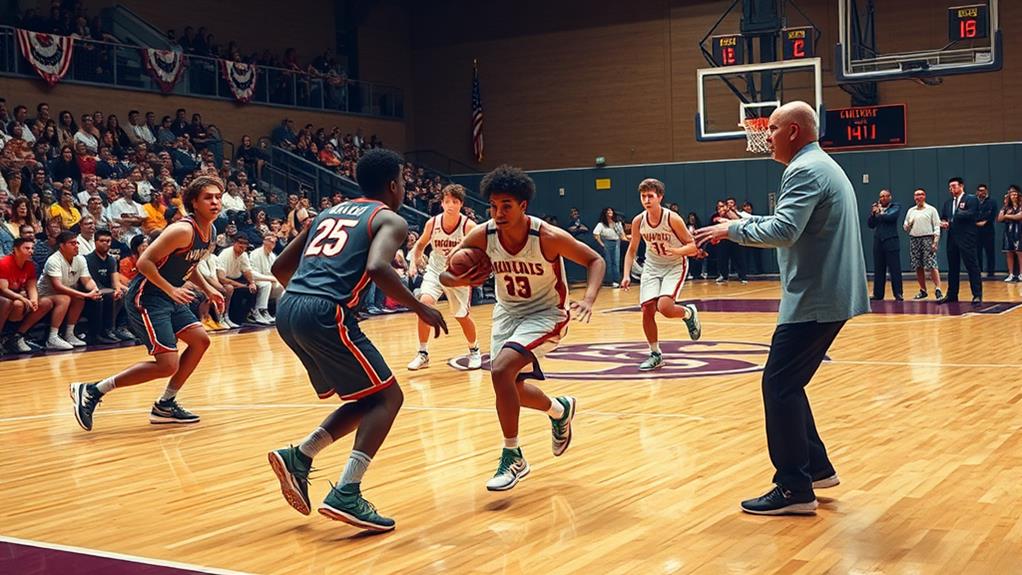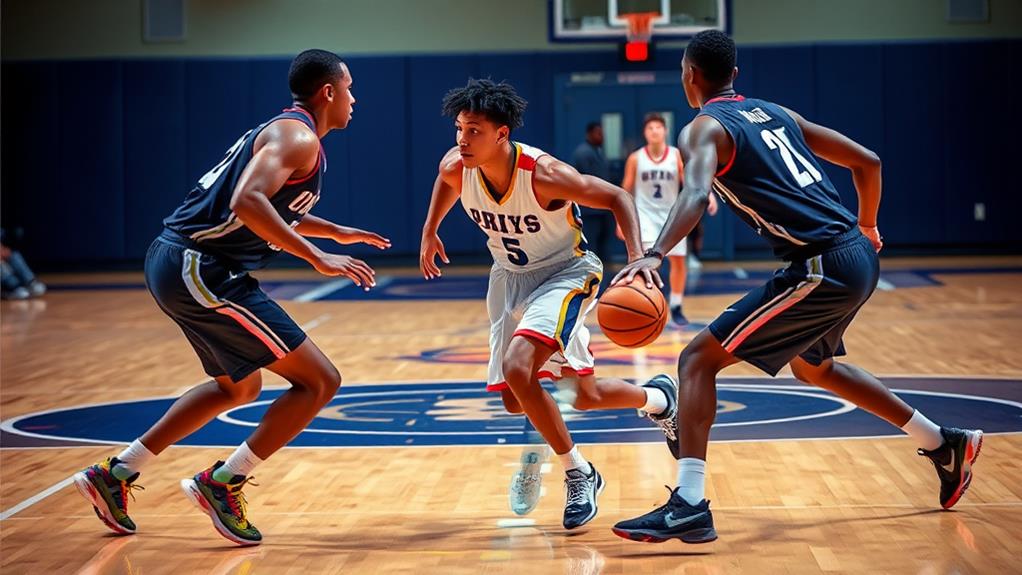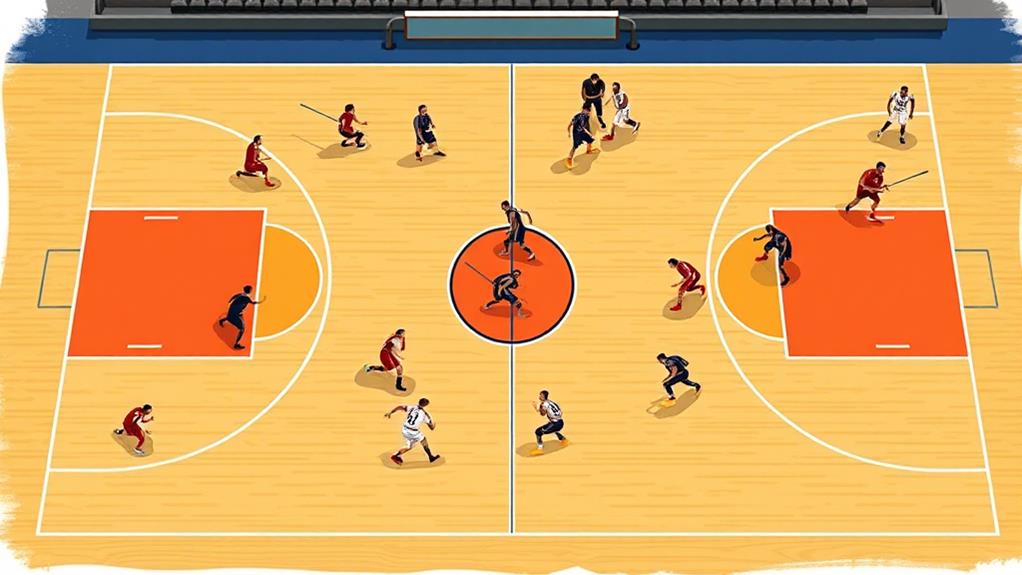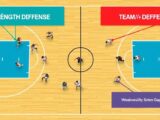
How to Break a Full-Court Press in Basketball
September 29, 2024To break a full-court press in basketball, stay calm and focus on strong ball handling and quick passing. Attack the middle defender to create gaps while making sure to avoid corners where traps often occur. Use quick inbounds to catch the defense off guard, and always keep your head up to anticipate your teammates' movements. Pivot to assess opportunities right after receiving the ball, and maintain spacing to avoid crowding. Construction of your approach with practice will enhance decision-making. There's more to mastering this tactic, so you might want to explore further strategies and drills for success.
Understanding Full-Court Press Strategies
While facing a full-court press can be intimidating, understanding its strategies is essential to breaking through. The full court press is designed to speed up ball handlers, pushing them into making mistakes like bad passes or turnovers. As a point guard, you need to see the defense clearly to exploit its weaknesses. Utilizing efficient play creation can help your team maximize scoring opportunities when breaking the press.
There are two main types of pressure: man-to-man, where defenders track individual players, and zone setups that cover specific areas. To effectively execute a press break, focus on attacking the middle defender, as this can create gaps in their formation.
Be aware of traps set in corners and along the sidelines—these areas can lead to you turning the ball over if you're not careful.
Mastering advanced ball handling techniques is vital, too. Skills like no-look passes and jab steps can make a significant difference in breaking the press. You'll want to maintain composure and make quick decisions to keep the defense off balance.
Key Inbounding Techniques
To effectively break a full-court press, mastering key inbounding techniques is vital. Quick inbounds are significant because they prevent defenders from setting up, allowing your team to maintain momentum and create valuable passing opportunities.
When you're inbounding the ball, aim to position yourself between the basket and the corner. This approach improves your passing lanes and reduces the likelihood of being trapped. In basketball, just as in fostering teamwork, creating an inclusive environment can enhance overall performance and player development, highlighting the importance of embracing diversity in player recruitment.
Using the baseline after an opponent's score offers a strategic advantage, letting you evade defenders while executing the inbound. As the ball handler, actively engage the defenders to create space for yourself. This guarantees you can receive the pass in a triple-threat position, ready to make a smart decision.
While inbounding, maintain a low stance; this enhances your dribbling and pivoting capabilities. A strong stance allows you to protect the ball and make quick movements necessary for a successful fast break.
Navigating Traps Effectively

After successfully inbounding the ball, you're likely to encounter traps set by defenders keen to regain control. To effectively navigate traps and break through full-court pressure, consider these strategies: cardio workouts can enhance your speed and endurance, which is vital in these high-pressure situations.
- Avoid trapping zones, especially corners, for better ball control.
- Always face defenders while keeping the ball low for better visibility.
- Utilize your pivot foot to maintain mobility and create escape options.
- Aggressively attack the outside legs of defenders to create space.
- Continuously keep your dribble alive to allow for quick passes or movement.
When facing traps, it's important to look up the floor to identify open teammates or potential passing lanes.
Keep your dribble alive as you maneuver through defenders; this keeps your options open and prevents them from closing in on you. Use your pivot foot wisely to shift your body and create angles for effective movement.
Passing Techniques for Success
To break a full-court press, you need to focus on making quick, accurate passes.
Prioritize passing accuracy to improve your overall effectiveness and guarantee your team can advance the ball efficiently. Keep your eyes up and anticipate where your teammates will be, so you can deliver the ball before defenders can react.
Remember, effective passing not only helps you advance the ball but also keeps the pressure off your team.
Additionally, incorporating techniques from soccer passing drills can enhance your coordination and decision-making on the court.
Quick, Accurate Passes
When facing a full-court press, quick and accurate passes are your best weapons. These passes minimize the time defenders have to react and disrupt your play.
Here are some key techniques to enhance your passing game:
- Use low, sharp passes to avoid interceptions.
- Always move toward the ball to create ideal passing angles.
- Pivot immediately to face down-court after receiving the ball.
- Maintain proper spacing to avoid crowding and keep the ball moving.
- Anticipate your teammates' movements by scanning the court before receiving the ball.
Anticipate Open Teammates
Quick, accurate passes lay the groundwork for breaking a full-court press, but knowing how to anticipate open teammates elevates your game even further. To do this effectively, you need to constantly scan the court before receiving the ball. This practice enhances your decision-making and allows for quicker, more efficient passing.
As you prepare to receive the ball, move toward it to create a clear passing lane, ensuring that you maintain proper spacing with your teammates.
Upon receiving the pass, pivot immediately to face down-court. This quick movement helps you assess scoring opportunities right away. Adopting a triple-threat position lets you choose whether to dribble, pass, or shoot based on the defense's coverage.
Press Breaker Systems Overview

Breaking a full-court press requires strategic organization and quick decision-making, making press breaker systems essential for any basketball team facing intense defensive pressure.
These systems help you efficiently counter the press while maximizing your offensive potential. Here's a quick overview of effective strategies to take into account:
- Press Breaker Systems: Utilize formations like the 80-60-40 or 1-1-2-1.
- Ball Movement: Focus on quick, precise passes to keep the defense off-balance.
- Weak-Side Player: Always maintain at least one player on the weak-side for ball reversal and additional options.
- Press Break Plays: Implement specific plays that cater to the type of press you're facing, such as calling out "Clear!" for man-to-man or "Zone!" for zone presses.
- Team Communication: Ascertain all players understand their roles to enhance effectiveness during high-pressure situations.
Coaching Tips for Player Development
Understanding your players' development is vital for overcoming a full-court press effectively. To help your team succeed, emphasize consistent practice of press-breaking techniques in controlled environments. Simulating full-court press scenarios allows players to catch the ball under pressure and make quick decisions.
Additionally, fostering a culture of teamwork and inclusivity can greatly enhance players' confidence in high-pressure situations, as sports serve as a platform for unity among diverse backgrounds. Encourage guards to maintain a central position on the court, using crossover, pullback, and hesitation dribbles to navigate through defenders. This positioning enhances their ability to find the open man and facilitates effective passing.
Remind players to prioritize court awareness, scanning for teammates to guarantee they don't rely solely on dribbling when facing pressure. Fostering teamwork and communication is essential. Establish clear roles and responsibilities during gameplay to guarantee everyone knows their part when the press tries to disrupt your offense.
Drills that promote these skills not only build confidence but also cohesion among players, making it easier for them to react collectively when facing a press.
Benefits of a Structured Approach

A structured approach to breaking a full-court press offers numerous advantages that can considerably elevate your team's performance. By implementing a clear strategy, you reduce confusion and enhance execution during high-pressure situations.
Modern defenses require teams to be adaptable and communicate effectively, reflecting the importance of structured gameplay in countering strategies like full-court presses informed defensive schemes.
Here are some key benefits:
- Defined Roles: Each player knows their responsibilities, leading to better player positioning.
- Standard Press Break Offense: Systems like the 80-60-40 allow for quick recognition and execution of positions.
- Improved Decision-Making: Regular practice in a 5-on-0 format reinforces skills, making players more confident in real games.
- Adaptability: Specific adjustments like the 21 flash help your team maintain offensive fluidity against various defenses.
- Enhanced Teamwork and Communication: A structured framework fosters better interactions, considerably reducing turnovers.
Conclusion
Breaking a full-court press is like maneuvering through a maze; it requires strategy, teamwork, and quick thinking. By mastering inbounding techniques, effectively handling traps, and using smart passing, you can turn pressure into opportunity. Embrace structured systems and focus on player development to elevate your game. Remember, every challenge is a chance to grow. With practice, you'll not only break the press but also build confidence, transforming obstacles into stepping stones toward success on the court.


